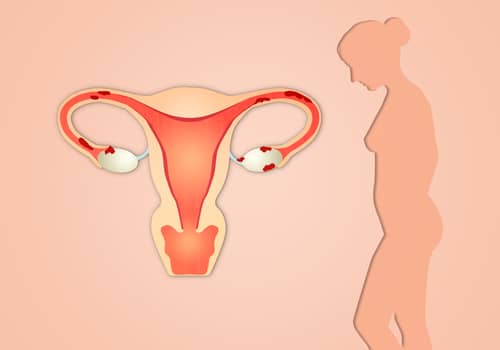Facts About Endometriosis
Endometriosis is one of the most common diseases among women. To understand…

Endometriosis is one of the most common diseases among women. To understand it, basic information is needed. The endometrium is the tissue lining the uterus. Female hormones, in women of child-bearing age, cause the lining of the uterus to get thicker with tissue and blood vessels. If a woman doesn’t get pregnant, the uterus sheds the tissue and blood – a menstrual period.
With endometriosis, the endometrium tissue grows outside of the uterus. It may be found on the ovaries, fallopian tubes, uterine ligaments, the lining of the pelvis, and other structures. The tissue responds to female hormones, thickening with tissue and blood vessels. Endometriosis can occur in any woman of child-bearing age, but is most common during the thirties and forties.
Symptoms
The most common symptom is pain, which can be severe, especially during menstruation. It can dramatically affect the quality of life, including missing school, work, and social contact. How painful it is does not depend on how much tissue is present outside the uterus. The pain can be chronic. There may be intestinal pain, pain with bowel movements, or during sex. There may be bleeding or spotting between periods.
Over time, the pain gets worse. The displaced tissue can become inflamed and form scar tissue, even adhesions that bind organs together. Additional symptoms include infertility, fatigue, diarrhea, constipation, bloating and nausea.
Symptoms tend to improve with pregnancy, and subside at menopause. Women taking hormones during menopause may continue to have severe symptoms.
Cause & Diagnosis
No one knows the cause of endometriosis. There are some factors that might increase your risk. Risk is higher in women who have never had children, have periods that last longer than 7 days, have menstrual cycles of less than 27 days, a family member with endometriosis, or damage to cells in the pelvis from an infection. There is no way to reduce the risk of endometriosis.
If you have symptoms of endometriosis, see your personal physician or a specialist in gynecology. It can be difficult to find the source of pelvic pain. The doctor will take a careful medical history and do a pelvic exam.
(S)he may do a pelvic ultrasound, inserting a rod shaped scanner into the vagina and another on the abdomen, with sound waves showing images of your internal organs. Magnetic resonance imaging (MRI) can also be used to show the organs.
Laparoscopy is a minor surgical procedure, and the only way to know for sure if endometriosis is present. Under general anesthesia, gas is used to inflate the abdomen. A tiny cut is made in your abdomen and a tube inserted, which has a camera on the end, to visualize the organs and abnormal tissue, if present. Sometimes it can be diagnosed just by seeing the growths. Other times, a small sample of tissue is needed for examination under a microscope.
Treatment
There’s no cure for endometriosis, but there are many treatments for the pain and infertility that it causes. Talk with your doctor about what option is best for you. The treatment you choose will depend on your age, symptoms and plans for getting pregnant.
Pain medication. For some women with mild symptoms, doctors may suggest medicines for pain. These include ibuprofen (Advil, Motrin) or naproxen (Aleve). When these medicines don’t help, doctors may recommend stronger pain relievers.
Hormone Treatment. When pain medication isn’t enough, hormone medicines may be effective. These drugs can be used only for women who don’t want to become pregnant. These treatments are best for women with small growths who do not have severe pain. They come in pills, shots, and nasal sprays.
Hormones used include birth control pills to prevent overgrowth of tissue that lines the uterus. Most birth control pills contain two hormones, estrogen and progestin. Once a woman stops taking them, she can get pregnant again, but the symptoms of endometriosis may return.
GnRH agonists and antagonists reduce the amount of estrogen in a woman’s body. Side effects are similar to those of menopause. Progestins can shrink spots of endometriosis by working against the effects of estrogen on the tissue. They will stop a woman’s menstrual periods, but can cause irregular vaginal bleeding. Danazol is a weak male hormone that lowers the estrogen and progesterone in a woman’s body.
Surgery. Surgery is usually the best choice for women with severe endometriosis. Laparoscopy can be used to diagnose and remove small amounts of endometrial tissue. Laparotomy involves a larger cut into the abdomen to remove larger amounts of tissue in the pelvis and abdomen. Hysterectomy is removal of the uterus. Removing the ovaries can help ensure that endometriosis will not return.
For more information on endometriosis visit The Endometriosis Foundation of Africa at www.endometriosisafrica.com.
For more health tips and expert advice, join our free weekly newsletter and receive a Radiant Health Magazine Issue No.06 digital issue for FREE. Download Now.
